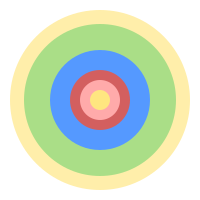Concentric zone model

The concentric zone model is a way of showing the patterns of how cities change. It has six zones, which spread out from the center of a city like a bullseye. It looks like this:
Zone 1: The City Center. This is the most built up and busy part of the city. This includes the downtown area with lots of shops, restaurants, businesses, and people.
Zone 2: Transition Zone. This area is just outside of Zone 1 and includes residential areas like neighborhoods and apartment buildings.
Zone 3: Working-class Zone. This area is home to people who work in the city center, but don’t have the money to live in the nicer areas.
Zone 4: Lower-class Zone. This zone is home to the poorest people in the city. People here usually have lower-paying jobs or no job at all.
Zone 5: Commuter Zone. This zone is outside of the city, but people who live here travel to work in the city center every day.
Zone 6: Rural Zone. This zone is outside of the city and is usually more rural, with farms, open fields, and smaller towns.
The concentric zone model shows that cities usually start in the city center and spread outward in these rings, like a bullseye.
Zone 1: The City Center. This is the most built up and busy part of the city. This includes the downtown area with lots of shops, restaurants, businesses, and people.
Zone 2: Transition Zone. This area is just outside of Zone 1 and includes residential areas like neighborhoods and apartment buildings.
Zone 3: Working-class Zone. This area is home to people who work in the city center, but don’t have the money to live in the nicer areas.
Zone 4: Lower-class Zone. This zone is home to the poorest people in the city. People here usually have lower-paying jobs or no job at all.
Zone 5: Commuter Zone. This zone is outside of the city, but people who live here travel to work in the city center every day.
Zone 6: Rural Zone. This zone is outside of the city and is usually more rural, with farms, open fields, and smaller towns.
The concentric zone model shows that cities usually start in the city center and spread outward in these rings, like a bullseye.
Related topics others have asked about:
